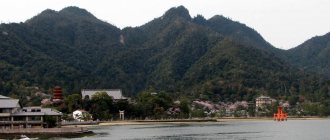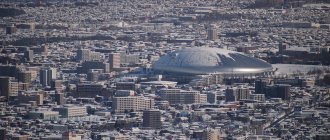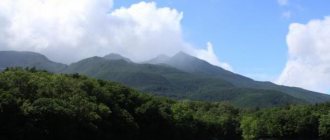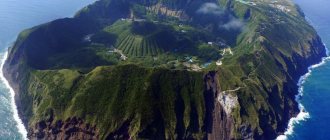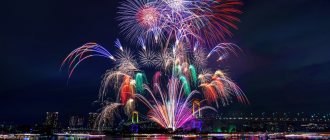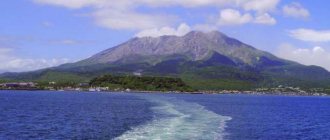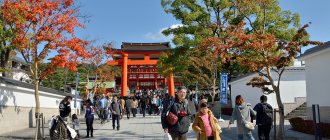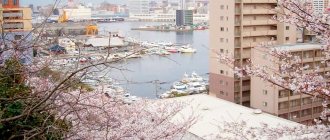Miyajima Island
Hiroshima is left behind. What happened? And this is what happened:
How to get to o. Miyajima from Hiroshima
In the morning, light breakfast at the hotel (as a rule, hotels do not offer breakfast included in the price - I stay in 3-4 stars, approximately 100-250 euros). I throw my backpack into a storage locker at the station. I buy a ticket for the train to Miyajima-Guchi , go through the turnstile, and travel for about 10 stops. At the desired station, I dive into the underground passage and now I’m already at the pier from where car and passenger ferries leave for Miyajima Island .
Here it is - a couple of kilometers away. Upon arrival on the island, I walk in the crowd of the same guests who arrived “from the mainland”. Now there are holidays in the country - I judge by the number of idly wandering public. I think it's like Buddhist Easter. I could of course be wrong...
Monkey Park (Misen Yaenkoen)
Along the embankment and mountain paths of Momijidani (Valley of Maple Trees) Park, deer and almost tame monkeys, always looking for a treat, roam. The island is home to a branch of the Japanese Monkey Research Center, which studies the life of these animals in natural conditions. The monkeys were brought and settled here in 1962. They seemed to like it in Miyajima.
31
Located at an altitude of 530 m, you may not see monkeys - they are hiding in the forest, but be prepared for the fact that the animals may attack the tourist if his movements are too sudden. There are 2 rules for communicating with monkeys: do not look them directly in the eyes and do not feed them. At the very top there are several small temples, among which there is said to be one built by the monk Kukai (774-835), the founder of the Shingon Buddhist sect.
32
You can get to Miyajima quite quickly: 30 minutes by comfortable train or minibus and another 10 minutes by ferry from Hiroshima. You can arrive in the city in the afternoon, but there is so much to see here that it is better to devote a whole day to exploring. Staying overnight is a big temptation, but hotels are not cheap.
Torii
Torii (鳥居), literally translated as "bird's perch", is a ritual gateway to Japanese shrines. In this case, at Itsukushima Shrine, the creation of which dates back to the 6th century. This sanctuary is recognized by the Japanese government as a national treasure, and UNESCO considers it a world heritage.
Torii are usually red in color and consist of two pillars connected at the top by two crossbars. Torii on Miyajima Island made from camphor wood in 1875. At high tide they are submerged in the water, but at low tide you can walk under them and take pictures. A very good sign, by the way
Itsukushima Jinja Shrine
Dedicated to the three sea goddesses, daughters of the Shinto god Susanoo, it was founded in 593 during the regency of Empress Suiko. It acquired its final form in 1168 under Tairano Kiyomori (1118-1181), the great leader of the Heike (Taira) clan and the penultimate ruler of the Heian era. The sanctuary building, with its attached covered corridors, is famous for its thatched roofs and bright orange carved woodwork. Built on stilts directly above the sea, at high tide it appears to float on water.
14
This is truly an outstanding example of Heian period temple architecture. Rows of bronze lanterns hang from the eaves; when they are lit on holidays along with stone lanterns, the effect is simply magical.
15
The famous torii gate described above is located 160 m from the shrine.
16
On the territory of the sanctuary there is a stage of the Noh theater, established in the 16th century, which is used in the sacred performances of Jin-No (April 16-18).
How to return from Fr. Miyajima to Hiroshima
Return route: Crossing from Miyajima Island by ferry. The train from Miyajima-Gucha to Hiroshima Station is about 10 stops. I pick up my backpack from the storage locker: very convenient, the cost of storage depends on the size of the locker, for my backpack it’s 400 yen. Another convenience: if you forgot where the storage locker is, then a person in any information center can determine the location of the storage locker using the number and color of the key and will show you.
Jido - patron of children and travelers
Heading from the shrine towards Mount Misen, you cannot miss the short, knee-length stone men dressed in knitted hats . The story behind these figurines in caps is one of the most amazing for a European tourist.
The fact is that in this way it is customary to depict Jizo - the intercessor of sinners in the kingdom of the dead and a fair judge for those who violated religious commandments . The hats are a gift from grateful parents whose children died in infancy or were stillborn and Jizo helps them in hell, where they are engaged in the construction of Buddha statues.
Buying senkansen tickets
With a backpack, I go to the green Ticket office - I need to buy a ticket for the high-speed train (senkansen) to Kumamoto. This city is located on another island - Kyushu .
- I select English on the machine’s touchscreen.
- I choose to take a ticket for today and without a seat: this means that I take any available seats on the train in 1, 2, 3 carriages.
- I select the destination station from the list: Kumomoto, confirm that I am going alone and only there, after which I receive the ticket price: 12,480 yen.
- I insert my credit card into the terminal and get a train ticket.
For all of 2 minutes. My train leaves in 15 minutes from platform 12.
- I pass the turnstile.
- I buy a set with some pieces of meat, fish, salted vegetables and rice.
- I climb onto the platform.
- I walk along it to the stop mark for the 2nd car and stand in the queue to board, which stands across the platform.
Exactly at 16:52 a handsome white train with a pointed nose approaches, passengers traveling to Hiroshima get off, and then we get on.
- I find an empty seat by the window.
- I plug my phone charger into the socket.
- I throw back the table and eat what I bought - it’s garbage, but you can eat it...
- I take coffee from a passing cart.
- I go to the end of the car to the smoking room.
- I smoke a cigarette.
- Then I open my laptop and write this text and I have 15 minutes left until my stop on another island of the Japanese archipelago: Kyushu Island , Kumamoto .
How to travel around Japan on your own
Japan scares me : I have never seen such clear logistics of movement anywhere. God forbid you get used to it, but you quickly get used to good things. Everything is clear. All clear. If you don’t understand, they’ll tell you with a smile. Everything is so logical and simple that I begin to doubt the intelligence of the Japanese, but this was made for them - I get the feeling that it was all made for children.
Don’t be afraid to travel around Japan: I have never seen a simpler process for organizing your trip anywhere else.
A little about Miyajima Island
About Miyajima : Allow half a day for it. There is nothing else to do there, unless you like to wander around the mountains with a staff. In the morning the water is full and you can take a boat and swim across the Torii, which are quite far from the shore. At the same time, you can make a wish and clap your hands to make it come true.
And after lunch you can walk under them along the former bottom of the sea: low tide. The Japanese pour out onto the bare bottom and extract shells from the sand. They come prepared with buckets and special mini-rakes. The 21st century is here, robots, but here you are, digging shells for dinner. This is how Japan is!
Tomorrow I'm heading to the Aso volcano , and will probably spend the night in Beppu . There are mud baths and a little rest. On April 10th I’ll fly to Tokyo - my needle there is full, and on the 11th I’ll go home.
